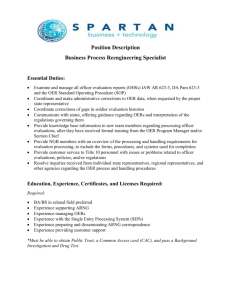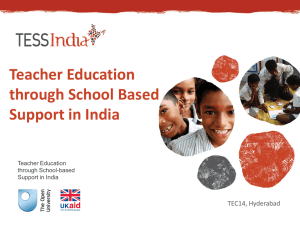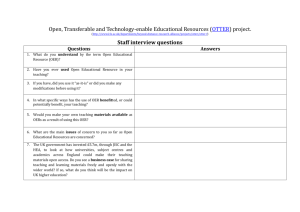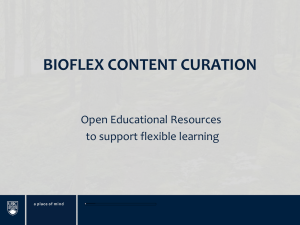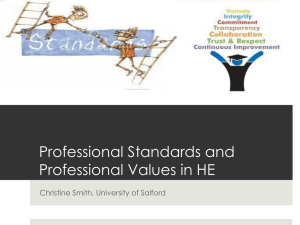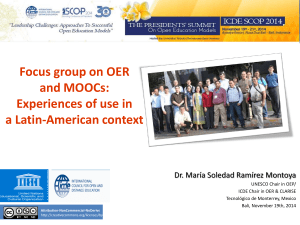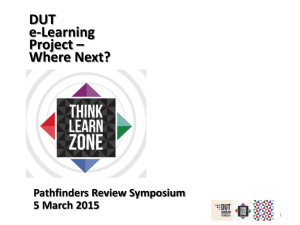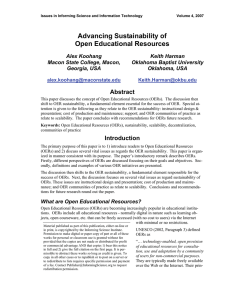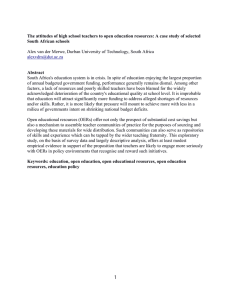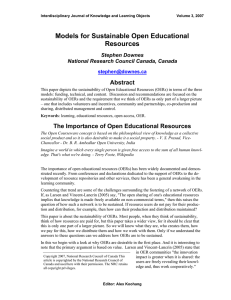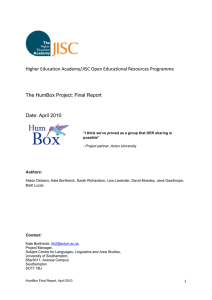Packaged OER - Center for Learning Technologies
advertisement
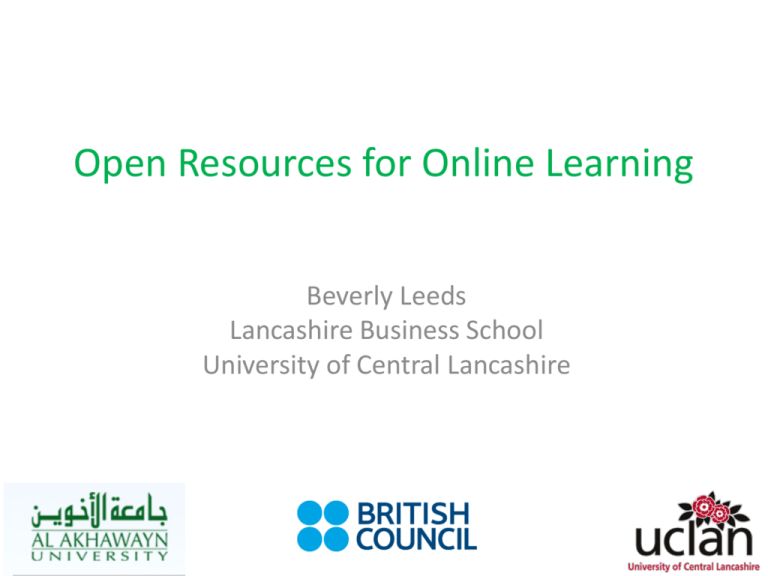
Open Resources for Online Learning Beverly Leeds Lancashire Business School University of Central Lancashire A little bit about me • Systems Design Consultant ICL Fujitsu • Principal Lecturer in Marketing • UK HEA National Teaching Fellow • Learning Enthusiast • Technology Explorer • Researcher One of the largest universities in Britain 180 years old 34,000 students of whom 20,000+ are in Preston Our mission is Access to Excellence Outline • • • • • • E-learning Positive and Negative What will the future hold? OOCs, MOOCs SPOCs and OERs Finding, Designing, Using and re-Using OER Future trends for Online Learning Traditional vs. e-Learning Traditional Learning Teacher Centered Single Media Isolated Work Information Delivery Factual-based Learning Bricks & Board Push approach E-Learning Student Centered Multimedia Collaborative Work Information Exchange Skills-based learning Technology-enabled learning Pull approach 5 Potential online-learning: Pros •New opportunities to maximize •Customized and flexible learning learning potentials •No commuting time or travel cost •No constraints of geographical location •Learning while working •Learning at her/his own pace •Just-In-Time (JIT) learning •Learning to fit busy schedule •Re-tooling for the unemployed •No campus space is required •Probably less costly •Greater learning resources available 6 Potential online-learning: Cons Instructors need to be effective Needs of students for equipment and service providers Hard for instructors to move traditional content online Academic integrity of online students Time consuming for individualized feedback Lack face-to-face interaction Technical training of learners Lack of regulations of learning practices and quality assurance Effectiveness of assessments Lack of e-learning culture Equity of access to learners of different backgrounds E-learning must be integrated into the mainstream accreditation and quality assurance – guidance, design delivery and assessment Requires new skills and responsibility from learners Lack of policies of intellectual property rights to protect e-learning content authors Content developers have to be trained in instructional design, learning theory Lack of social interactive aspects of campus and classrooms 7 Future of e-Learning? • Nobody has the exact answer • Graduates will be exposed to new information in one year than their grandparents in a lifetime. • Memorizing facts will have lower value, than utilizing information for decision-making. • Change of career. • Lifelong learning. • Just-in-Time (JIT) learning. • Career development: learning by the corporate • Telecommuting learning: distance 8 rossirogerio@hotmail.com pollyana.mustaro@mackenzie.br OOC (Open Online Course) (Väljataga, & Põldoja Laanpere, 2011) • Teacher involvement • Interaction mechanisms Enables Configuration of learning communities Peers' feedback (teaching strategy) (Fini et al., 2008) Alec Couros Social Media Open Education rossirogerio@hotmail.com pollyana.mustaro@mackenzie.br cMOOCs (Siemens, 2005) • Learning is a lifelong process and it is mediated by social networks (communities of practice / performing activities) • Technology has been changing the way people think • Processing cognitive information can be supported by technology • Interlinked dimensions (enables to understand where to find a certain knowledge) Integrate Multiple points of view Networks Chaos Self-organization Complexity Connections’ contant updated rossirogerio@hotmail.com pollyana.mustaro@mackenzie.br xMOOCs • • • • • • Open manner Open-source Tools (charge on registration) Thousands of students Open Structure (flexible) Open source information Open evaluative processes Guided (McAuley et al., 2010) Participants' self-organization Fragmentation Emergence Online social network Key Players NAME EdX (May 2012) TYPE FUNDING BUSINESS MODEL PARTNERS COURSES Academic MIT, Harvard: $30m each U. of Tex: $5m Gates: $1m Non-profit; Plans to charge fee for certificates of completion 29 including MIT Harvard UC Berkeley HKU 59 courses at October 2013; 1,200,000 users Academic VC: $16m (KPCB, NEA) Add’l equity $6m (including Cal Tech, Penn) For-profit; Plans to charge for certification, testing, sale of student info, etc 83 University partners, including: Columbia U. Of Toronto U. of Washington 400 courses at June 2013 ; 4,700,000 users (Sept 2013) Academic VC: $22m (Andreesen Horowitz, Charles River, Steve Blank) For-profit; In-person proctored exam $89; Job placement; Plans for fee-based online secure exams Notables: Sebastian Thrun Peter Norvig Steve Huffman 30 courses 750,000 users (January 2012) Coursera (April 2012) Udacity (February 2012) Adapted from: Jim Michalko, MOOCs and Libraries, http://www.oclc.org/research/events/2013/03-18.html MOOC benefits Students Institutions • Open and global • Institutional mission • No size limit • Low costs • No pre-requisites • Potential revenue • Free (mostly) education • Student driven • Prestige • Large volumes of data related to student behaviours MOOC limitations Students • No formal accreditation Institutions • No pre-requisites • No size limit (truly scalable?) • No (little) student teacher interaction • Assessment (Automated or crowdsourced) • Assessment (Automated or crowdsourced) • Cheating • 3rd party platforms • Cheating • “Next big thing” syndrome • High participation – low success • Limited support (e.g. library) • Copyright issues Solutions? What’s the problem? • Poor retention V Intentions to complete • No credit V Accreditation of Prior Learning • MOOCs are like books • Real Problem is business model SPOCs • Small Private Online Courses • Still publicly available • Selective • Credit possibilities Gartner Hype Cycle http://en.wikipedia.org/wiki/Hype_cycle Open Educational Resources • The Hewlett Foundation define OERs as “teaching, learning and research resources that reside in the public domain or have been released under an intellectual property license that permits their free use or repurposing by others. Open Educational Resources include full courses, course materials, modules, textbooks, streaming videos, tests, software, and any other tools, materials or techniques used to support access to knowledge.” (Atkins et al, 2007). Open Educational Resources • Longer history than MOOCs • Many supporters. – UK Government £5.7 Million – Hewlett Foundation • Typically provided as courses but also include smaller units of learning • Components of audio, text or image files • Available on the internet free of charge usually under a Creative Commons License (Creative Commons, 2007) Finding OER • • • • • • iTunesU: http://www.apple.com/education/itunes-u/ TEDtalks: http://www.ted.com/ Humbox: http://www.humbox.ac.uk/ CETL: http://www.rlo-cetl.ac.uk/ Jorum: http://www.jorum.ac.uk/ OpenLearn: http://openlearn.open.ac.uk/ • Comprehensive list provided by Wolverhamton Blended Learning Unit here My Funded OER Projects Designing Online Learning Process Model of Learning Content empty vessel Process learning cycle Teacher is facilitator Learner is participant Knowledge is experienced Teacher is expert Learner is recipient Knowledge is given Learner learning styles Teacher is guide Learner is central Knowledge is discovered Doel et al, 2002 Considerations • • • • • • • Role of teacher/student Online approach Example of software Instructional strategy Evaluation Link to Bloom’s Taxonomy Role of Media Crighton and Childs (2008) Modular Approach • Systems or Flexible Approach? • Modular approach combines both • Select Instructional model/pedagogic approach [ • Modular Approach using Open Educational Resources speeds up development “the process of planning a quality e-learning experience is very likely to be more complex and time-consuming than planning a conventional classroom experience. (Anderson & Elloumi, 2004) See http://carbon.ucdenver.edu/~mryder/itc_data/i dmodels.html for a comprehensive list.] OERs as Learning Objects • Breaking educational material down into modular ‘chunks’ (objects) • Each object can have its own defining properties tagged • Combined with other objects, assembled into sequences • Adopted Definition of Learning Object: – “any digital resource that can be reused to support learning” (Wiley, 2000) Modularizing course development: think of courses as several blocks which together form a larger unit’ Campbell (2004) Characteristics of Reusable Resources • • • • • • • Autonomous Customisable Accessible Available Durable Interoperable Appropriately sized Hernandez et al (2008) • Sharable • Modular • Pedagogy as part of the packaging • Open licence • Template format Re-Usable OERs • “The Four R’s” : – – – – Re-use: Rework: Remix: Redistribute: • “The Four F’s”: – – – – Freedom to copy; Freedom to modify; Freedom to redistribute; Freedom to redistribute modified versions Wiley (2007) OERs licensed under a Creative Commons AttributionNonCommercial-ShareAlike 3.0 Unported License. Creating OERs at UCLan • Single resource • Pedagogically independent • Variety of formats – – – – – Audio Video Text Animation Cartoon • Mini lectures using Adobe Presenter • Packaged using PebblePad – a personal learning environment. • Different Types – Information giving – Assessment – Case Stories • Accessible Packaging OER Using Gagne et al’s Nine Events of Instruction (1985) 1. 2. 3. 4. 5. 6. 7. 8. 9. Introduction, Learning outcomes, Reflection on prior learning, Presentation of content, Specified tasks for guidance Elicit performance Practice, Feedback for tasks, Assessment Enhance retention / guidance on further study or practice. Re-using OERs to create OERs Learning Activity Introduction And Learning Outcomes Tasks Resource Resource Resource Resource Resource Resource Creating Packaged OER at UCLan • • • • • • • • • Independent of VLE Stand alone Lesson plan format Learning Outcomes Mixture of existing and newly developed OER Packaged in web format using PebblePad Sequence of tasks that use the OERs Easily re-sequenced, repackaged or amended Shared through OER repository and other public repositories. Different Pedagogies by mixing content and tasks Inform Apply Inform Assess Assess Inform Apply Inform Apply Assess Assess Apply Exploratory Enquiry Based Directive Diagnostic Re-useable Learning Objects Learning Activity 1 Learning Activity 2 Introduction And Learning Outcomes Mini Lecture Introduction And Learning Outcomes Tasks Quiz Tasks Reading Mini-lecture Web link Web link Different Pedagogies 2013 Horizon Report on Future Technologies • Near Term – Massively open Online Courses (MOOCs) – Tablet Computing • Mid-Term – Games and Gamification – Learning Analytics • Far Term – 3 D printing – Wearable technology - appcessories Variable Pricing Paperless Education Life Streaming Live Human Centred Technology P2P Crowd Sourced Translation Flexible Screens Low tech Device Charging Biometric Authentification Emotion Recognition rossirogerio@hotmail.com pollyana.mustaro@mackenzie.br Beverly Leeds, bleeds@uclan.ac.uk OERs (packaged and single resources) available from www.jorum.ac.uk and www.employability.org.uk
